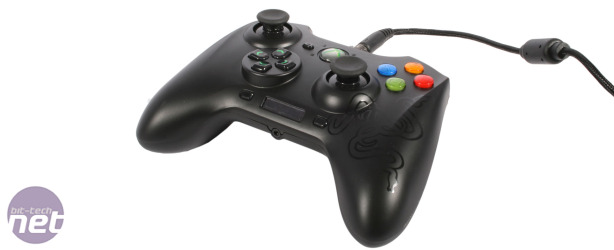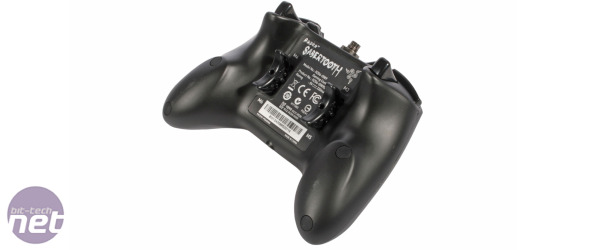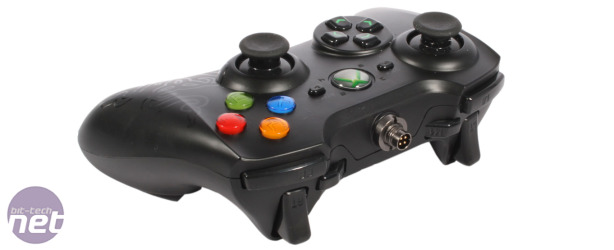
Razer Sabertooth Review
Manufacturer: RazerUK Price (as reviewed): £69.59 (inc VAT)
US Price (as reviewed): $79.99 (ex Tax)
While you’ll have to pry our mice and keyboard from our cold dead hands when it comes to strategy games or first person shooters, Microsoft’s Xbox 360 controller has long been the go-to choice for PC gamers when it comes to racing games, platformers or anything played in Steam’s Big Picture mode. However, unlike the PC peripheral market where there’s near endless choice and competition, third party Xbox or PS3 controllers are far fewer, the task of surpassing the default pads seemingly too herculean. We’ve all been round to a friend’s house and had to play on that naff second controller, experiencing the result of these efforts, so it was with some trepidation that we un-boxed the Razer Sabertooth, a premium (but fully licensed) Xbox 360 Game pad.
As you’d expect from a company with Razer’s peripheral pedigree, the Sabertooth isn’t just an Xbox 360 Pad in black. While it retains the same basic shape the controller is more angular and felt a better fit than the default 360 pad in our hands. However, this is somewhat spoilt by the addition of a pair of rocker switched on the pad’s underside. While these don’t operate as extra buttons to map additional controls to too, you can re-map existing buttons, such as the X,Y,A, or B buttons to them. There are also a third pair of shoulder bumpers which can also receive re-mapped commands, with the idea that in competitive gameplay, you’ll never need to take a finger or thumb off of the pad to execute a move.
In practise however it takes some getting used to, having spent 35 years of our lives leaving our ring and little fingers dangling like the gaming equivalent of vestigial digits. We fired up some Call of Duty and re-mapped the grenade and reload commands to the rockers, but found ourselves still reaching for the more familiar mapped points. The rockers also meant that the pad needs to sit in your hands rather than be firmly gripped, something that doesn’t always match up with the aggressive nature of competitive play. We’re sure with sufficient training and practise the rockers and additional pair of shoulder bumpers would give you that miniscule advantage, but we were happier to find that the rockers were fully removable by the use of a small (included) screw driver.

Click to enlarge - An extra pair of shoulder bumpers can also have current controls remapped to them
The re-mapping controls are configured using a small LCD display built right in to the controller, from which you can also enable/disable the pad’s rumble command and toggle the admittedly attractive under-pad lighting that the Sabertooth sports. The X,Y,A,and B buttons all light up, as does the re-designed D-Pad. Despite being well implemented though, the LCD screen is poorly utilised; other than some menus for settings, there’s no way for it to display controller statistics or custom animations.
More welcome (and practical) is the replacement of the X, Y, A and B button’s triggers with very sensitive micro switches. They’re satisfying to press, with a distinctive click, but have far less travel than a traditional Xbox controller. The D-Pad has also been swapped out, with four individual buttons replacing the always unconvincing stock d-pad.
While these are pleasant improvements, the Sabertooth misses a trick with the complete removal of the pad’s wireless capabilities. While being wireless adds 100-150ms in controller response time, it’s still one of the best features of this generation of consoles; no one likes tripping over cables. Although the Sabertooth’s cable is nicely braided and even screws into place on the controller, the total lack of wireless capability is more of a chore than an edge after we’ve gotten so used to not having to trail cables across our living rooms.
Conclusion
Despite its shortcomings though, the Sabertooth does both look and feel like a premium game pad and sat in our hands mid-game we must admit to feeling at least 20 per cent cooler (a feeling somewhat neutered by the fact we were playing Lego Lord of the Rings for a good chunk of the review process). The buttons are on hair-trigger micro switches that feel very satisfying, the sticks move smoothly and the extra features, while arguably superfluous for most, are there for those few who consider them a game breaking advantage (which they aren’t – this isn’t a pad equipped with auto-fire to mappable macros after all).While we like the Sabertooth then, we’re certainly not fans of its price tag. At £70 it’s vastly more expensive than a standard wired black Xbox controller that can be had for less than £20, while a wireless pad with PC adapter is still cheaper at closer to £40. For most, the extra features just won’t be worth the extra cash, particularly with the loss of wireless functionality.
If you’re a controller die-hard or do most of your gaming through Xbox Live rather than Steam though, we can certainly see the attraction of trading up to a controller with a little more about it than Microsoft’s old-faithful, and the Sabertooth fits that niche well; just don't expect it to turn you into a scoreboard-topping pro-gamer all by itself.
-
Value12 / 25
-
Features29 / 35
-
Design32 / 40


MSI MPG Velox 100R Chassis Review
October 14 2021 | 15:04











Want to comment? Please log in.